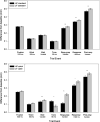Pupil-BLAH-metry: cognitive effort in speech planning reflected by pupil dilation
- PMID: 22231605
- PMCID: PMC5543177
- DOI: 10.3758/s13414-011-0263-y
Pupil-BLAH-metry: cognitive effort in speech planning reflected by pupil dilation
Abstract
In reading research, a longstanding question is whether any stages of lexical processing require central attention, and whether such potential demands are frequency-sensitive. In the present study, we examined the allocation of cognitive effort in lexical processing by examining pupil dilations and naming latencies in a modified delayed naming procedure. In this dual-task/change procedure, participants read words and waited for various delays before being signaled to issue a response. On most trials (80%), participants issued a standard naming response. On the remaining trials, they were cued to abandon the original speech plan, saying "blah" instead, thereby equating production across different words. Using feature-matched low- and high-frequency words, we observed the differences in pupil dilations as a function of word frequency. Indeed, frequency-sensitive cognitive demands were seen in word processing, even after naming responses were issued. The results suggest that word perception and/or speech planning requires the frequency-sensitive allocation of cognitive resources.
Figures




References
-
- Andrews S. Frequency and neighborhood effects on lexical access: Activation or search? Journal of Experimental Psychology: Learning, Memory, and Cognition. 1989;15:802–814. doi: 10.1037/0278-7393.15.5.802. - DOI
-
- Andrews S. Frequency and neighborhood effects on lexical access: Lexical similarity or orthographic redundancy? Journal of Experimental Psychology: Learning, Memory, and Cognition. 1992;2:234–254. doi: 10.1037/0278-7393.18.2.234. - DOI
-
- Balota DA, Chumbley JI. The locus of word-frequency effects in the pronunciation task: Lexical access and/or production? Journal of Memory and Language. 1985;24:89–106. doi: 10.1016/0749-596X(85)90017-8. - DOI
Publication types
MeSH terms
Grants and funding
LinkOut - more resources
Full Text Sources

